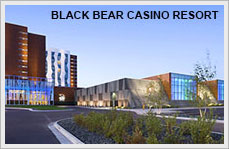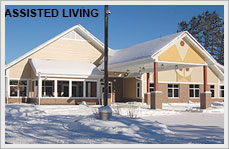Additional Air Quality Issues
Visibility and Regional Haze
The air program is also involved in activities related to Class I Air and National Tribal Air issues. FDL is involved in a regional haze workgroup that includes state and tribal agencies from nine Midwestern states. The group also includes representatives of industry, environmental groups, the Environmental Protection Agency, the National Fish and Wildlife Service, the National Park Service, and the U.S. Forest Service. The purpose of the group is to improve visibility in the nation's national parks like Yellowstone and Yosemite. The actions taken will improve and protect air quality in many other areas too, like the Boundary Waters. Participation in groups like this increases the presence of tribal environmental programs and serves to educate others about tribal issues.
There are several related national tribal air quality issues that are of concern, including New Source Review and Prevention of Significant Deterioration (NSR/PSD) and minor source permitting issues.
AirNow: Air Quality by Zip Code, City or State
Interagency Monitoring of Protected Visual Environments:
National Parks and Wilderness Areas

IMPROVE: Boundary Waters Canoe Area Wilderness: Superior National Forest
Interagency Monitoring of Protected Visual Environments (IMPROVE) is the cornerstone for characterizing aerosol pollutants reducing visibility. The US Environmental Protection Agency funds aerosol sampling and analyses at Forest Service-operated sites; Forest Service-funded optical devices corroborate aerosol measurements. Cameras capture visibility conditions from important vistas near 80 Forest Service managed Class I areas.
Boundary Waters Real Time Image

Pristine

September 14, 2008

Haze Event, 2/11/1994

Forest Fire 40 miles for site, 6/15/1996
Midwest Hazecam
A composite photo of the St. Paul skyline

PM2.5 levels of 5 μg/m3 (left) and 35 μg/m3 (right)
Regional Ambient Air Quality Concerns
Air pollution that lingers in the atmosphere for long periods of time can be transported great distances. As a result, many pollutants cause regional problems far from their emission sources. These regional problems include impaired visibility, acid rain, and smoke from open and prescribed burning.
Visibility
Airborne particulate matter, which includes solid particles as well as liquids and gases, is the main ingredient in haze. Haze impairs visibility because the fine particles within the airborne particulate matter scatter and absorb light, limiting the ability to see distant objects. Some particles, such as sulfates and nitrates, become larger as humidity in the air increases, resulting in even more haze and reduced visibility. Weather conditions can also cause chemical reactions between air pollutants, creating fine particles that remain in the air for several days. As a result, particles transported from urban and industrial areas may contribute to poor visibility in national parks and other wilderness regions.
The eastern United States has poorer visibility than the western part of the country due to generally higher humidity levels and a greater number of independent sources that emit particulate matter. Visibility in the eastern United States should be approximately 90 miles, but regional haze has reduced it to between 14 and 24 miles. In the western United States, visibility should be about 140 miles, but is currently closer to 33 to 90 miles due to regional haze. Visibility varies seasonally and is generally worse during the summer months, when humidity is higher and the air is stagnant.
Acid Rain
Acid rain is formed when sulfur dioxide and nitrogen oxides are released into the atmosphere, where they react with water, oxygen, and oxidants to form acidic compounds. These compounds fall to Earth in either dry form (gas and particles) or wet form (rain, fog, or snow). Smog, a combination of ozone and hydrocarbon pollutants, is also considered a form of acid rain. It is typically associated with large urban areas that have periods of stagnant air and warm temperatures.
Health and Environmental Effects:
Major human health concerns associated with exposure to acid rain include effects on breathing and the respiratory system, damage to lung tissue, cancer, and premature death. In the environment, acid rain raises the acid levels of lakes and streams, making the water unsuitable for fish and aquatic life.
Prevention of Significant Deterioration/New Source Review
The Clean Air Act requires that all new and modified stationary sources of air pollution obtain a preconstruction permit. This New Source Review permitting process is required in both nonattainment areas, where national ambient air standards have been exceeded, as well as attainment and unclassified areas, where air quality is currently acceptable. In nonattainment areas, these permits are called Nonattainment Area Permits. Permits in attainment or unclassified areas are called Prevention of Significant Deterioration (PSD) permits. EPA has identified three basic goals of the PSD regulations:
- to ensure that economic growth will occur in harmony with the preservation of existing clean air resources;
- to protect the public health and welfare from any adverse effects that might occur, even when air pollution levels are better than state and national standards;
- to preserve, protect, and enhance the air quality in areas of natural, recreational, scenic, or historic value, such as national parks and wilderness areas.
New and modified pollution sources under PSD review must show that they have the Best Available Control Technology (BACT). These sources must also conduct an ambient air quality analysis to show that they will meet all air quality standards. The permitting process further requires a review of air quality effects on soils, vegetation, and visibility. New and modified sources may not adversely affect any area designated as Class I that include national parks, some tribal reservations, and wilderness areas. Public participation is also required as a part of the permitting process.
Prevention of Significant Deterioration (PSD) area classification requirements let states plan for local land use. Each PSD classification differs in the amount of development it will allow. Acceptable growth is estimated using computerized air dispersion modeling techniques to gauge the effects of current and potential pollution sources on surrounding areas. PSD regulations allow for three area classifications:
Class I areas allow the smallest incremental growth and accommodate only a small degree of air quality deterioration while also trying to return the area to natural air conditions if necessary;
Class II areas can accommodate normal, well-managed industrial growth; and
Class III areas allow the largest increments of growth and provide for a larger amount of development than either Class I or Class II areas.
Congress has identified several mandatory Class I areas and allows state and tribal authorities to designate other Class I areas.








